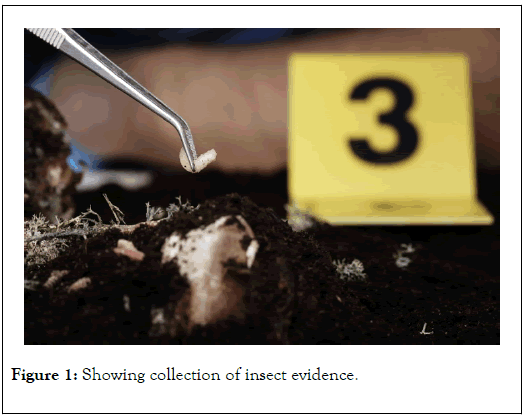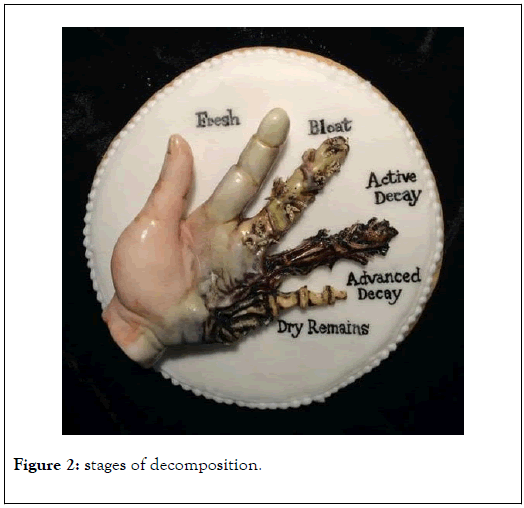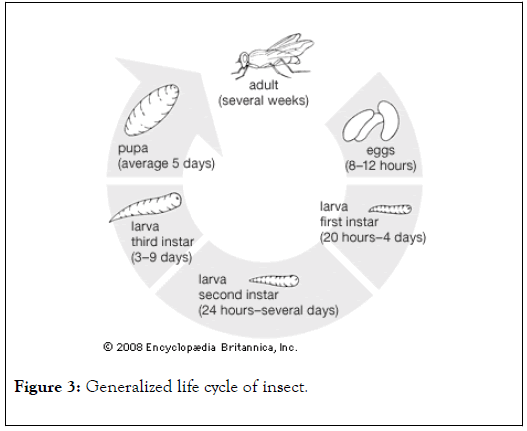Entomology, Ornithology & Herpetology: Current Research
Open Access
ISSN: 2161-0983
ISSN: 2161-0983
Mini Review - (2020)Volume 9, Issue 3
The analysis of insects in criminal investigation is forensic entomology. Evidence from insects is useful if the information they provide is collected and interpreted appropriately. Insects can help you understand what happened in a criminal case and you can find them everywhere. The insects are the most common species on land and in the wetlands. Insects are drawn to the decomposing body right from the early stages, and can lay eggs in it. Forensic scientists may estimate the post-mortem index, any change in the location of the corpse as well as the cause of death by observing the insect population and the evolving larval stages.
Forensic; Entomology; Insects; Larvae; Investigation
Forensic entomology is the examination of insects associated with a human body in criminal investigation. Insects or arthropods exist in a decomposing vertebrate corpse [1]. Such insect colonizers can be used to measure the time of death, i.e., the time period between death and corpse detection, also known as the postmortem index (PMI), corpse activity, manner and cause of death, and the presence of suspects at the death scene [2].
Insect evidence can also indicate that the body was relocated to a second site after death, or that at some stage the body was disturbed, either by animals, or by the murderer returning to the crime scene (Figure 1). But the primary aim of today’s forensic entomology is to assess the time elapsed after death. The first documented event in which insects were used in a criminal investigation occurred in China in the 13th century as mentioned in Sung Tzu’s novel, “The Washing Away of Wrongs” [3].

Figure 1. Showing collection of insect evidence.
The first use of forensic entomology in a modern court house was in France of the 18th century, where entomological data was used as evidence to acquit the existing inhabitants of the home from which a child's skeletonized remains were recovered.
In the 18th century Yovanovich and Megnin's examination of the insect succession on corpses established the science of forensic entomology [1]. Yet forensic entomology has become increasingly popular in police investigations over the last 20 years. In 1996, some of us established the American Board of Forensic Entomology, a forensic entomologist ’ s certification program, similar to the board certification offered to forensic dentists and forensic anthropologists.
When death occurs, cells begin to die, and enzymes begin digesting the cells inside out in a cycle called autolysis. The body commences to decompose. In the gastrointestinal tract, bacteria begin to destroy the soft tissue that produces liquids and gases such as hydrogen sulphide, carbon dioxide, methane, ammonia, sulfur dioxide and hydrogen [4].
Insects are attracted by the volatile compounds called apeneumones escaping from the decomposing body. Scientists are able to isolate the volatile chemicals released at different stages of body decomposition. The insect behavior may be modified by the volatile molecules released during each stage [5].
According to Smith, four categories of insects can be found on the decomposing carrion: first category is Necrophagous species feeding on the carrion; predators and parasites feeding on the necrophagous species is the second category and this group also includes schizophagous species which first feed on the body and which later become predatory; third category is Omnivorous species that feed on carriions and other arthropods such as ants, wasps and some beetles; other species such as springtails and spiders comes under the fourth category that use the corpse as an extension of their home [1].
Based on the physical appearance of the dead body and internal temperature, K Tullies and ML Goff have identified the decomposition of the body in combination with the insect colonies into five phases.
Fresh Stage: This stage remains 1-2 days, and it is the initial decomposition stage. Cellular degradation occurs in this. The dead body attracts insects. There is no oviposition at this stage and is not considered to be egg laying during this stage [5].
Bloated Stage: This stage has a period of 2-7 days. At this point, the putrefaction happens. Gasses accumulate in the parts of the body which give the body a bloated stage. A great number of insects of Diptera can be seen on the dead body at this stage. On the fourth day Diptera was present at the first- and early second-star or larval stages. Also several Diptera larvae predators were recovered from the carcasses by the start of Day 2.
Decay Stage: This period has duration of 5-13 days. The body started rotting. Due to gaseous release the walls of the abdomen get penetrated causing the carcass to deflate and the bloated stage to end. The internal temperature rises to 14 degrees above the ambient temperature, followed by a drop signifying the end of this stage. Decaying odors are strong during elevated temperatures and decrease as temperature rises. This is also related to a drop in body weight after 10 days. The larvae develop into the pupate stage.
Post-Decay Stage: This stage takes 10-23 days to complete. It begins with the Dipteral larval stage that feeds on the remaining bones, cartilages, hair and tiny portions of tissues and a large quantity of wet, viscous material known as decay by-products (BODs). During this stage the BOD is the major site of arthropod activity [4].
Dry Remain Stage: This period lasts from 18-90 days. It begins over the dried bones and other skeletal remains during the 18th day. The BOD has dried up. It is the final decompositional step. This is correlated with shrinkage in the insect population (Figure 2) [6].

Figure 2. stages of decomposition.
Most cases involving a forensic entomologist are 72 hours or older, as other forensic methods are equally or more accurate than the insect evidence up until this time. However, insect evidence is often the most accurate and sometimes the only way to determine the time elapsed since death, after three days. There are two significant purposes of insects to assess the time elapsed after death.
The use of successional waves of insects
This method is based on the fact that a human body supports a rapidly changing ecosystem from fresh to dry bones within weeks or months depending on the geographical area. The remains undergo rapid physical, biological and chemical changes during this decomposition, and various stages of decomposition are desirable for different insect species. Many insect species are also the first witnesses to a criminal offence.
These first classes of insects are the Calliphoridae or blowflies, and the fleshflies. Many species aren't interested in the corpse while the body is young, but are only drawn later on to the corpse such as the Piophilidae or cheese skippers that arrive later during protein fermentation. Many insects aren't specifically drawn to the body yet arrive at the scene to feed on the other insects. At through decomposition point several organisms are involved, and each group of insects often overlaps those adjacent to it.
Therefore the insect assemblage associated with the remains can be studied with knowledge of the regional insect fauna and periods of carriage colonization to determine a time period in which death occurred. This technique is used when the decedent is dead from a couple of weeks up to a year, or in several cases several years after death, with the approximate time period extending as time rises after death. It can also be used to indicate death season, e.g. in early summer. To be effective this approach needs knowledge of insect succession along with geographical, seasonal, climate, and meteorological variations [7].
The use of the maggot age and development
In this method the use of maggot age and growth, will provide an accurate date of death to one day or less, or range of days, and is used in the first few weeks after death. Maggots are larvae or immature Diptera stages or two-winged flies. The insects used in this method are those that first arrive on the corpse, i.e., the Calliphoridae or blowflies.
Very soon after death, these flies are drawn to a corpse. They lay their eggs on the body, normally in a wound, if present or not, then in any of the orifices of nature. Their creation follows a process sequence which is set and predictable. The insect egg is laid on the corpse in batches and hatches into a larva of the first instar after a fixed period of time. The larva feeds on the corpse and moults into a larva of the second instar.
The larva continues feeding and evolving into a larva of the third instar. The stage can be determined by size and number of the spiracles. If the larva continues to feed for a while in the third case, it stops feeding and wanders away from the corpse to find a safe place to pupate, either in the clothes or in the dirt. This stage of non-fed wandering is called prepupa. So the larva loosens from its outer skin but stays inside.
This outer shell becomes a hard protective outer shell or pupal case that shields the insect as it transforms it into an adult. The freshly developed pupae are light in colour, but in a few hours they can darken to a deep brown. An adult fly will emerge from the pupa after a number of days and the cycle will start over again. The empty pupal case is left behind as evidence of a fly growing and emerging when the adult has arisen (Figure 3).

Figure 3. Generalized life cycle of insect.
Each one of these stages of development takes a fixed, established period. The time-limit is dependent on food quality and temperature. Food supply is usually not a limiting factor in the case of a human corpse. Insects are 'cold blooded' and so their production is highly dependent on temperature.
Their metabolic rate increases with higher temperature, resulting in a faster rate of development, leading to a linear decrease in development duration with higher temperature, and vice versa. The examination of the oldest stage of insects on the body and the temperature of the area where the body was discovered leads to a day or a number of days when the first insects oviposited or laid eggs on the body.
That, in effect, results in a day, or series of days, on which death occurred. For example, if the oldest insects are seven days old, then the decedent is dead for at least seven days. This approach should be used before the first adults start appearing, after which it is difficult to decide which generation is present. Therefore the time of death is determined using the first method that of insect succession, after a single generation of blowfly has been completed [8-10].
The identification of the correct species is an important initial step in determining the larvae age. Morphological comparison is typically used to classify species which needs specific expertise and often takes time. Appropriate regions of the larvae genomes can be made by polymerized chain reaction amplification and compared with reference data to address this challenge species identification.
The larvae of the flies that feed on the carrion will absorb drugs that the deceased has ingested and this includes the examination of insect samples obtained from the crime scene or in near proximity to the carcass or remains that are dead. This can help to establish whether before death the body had been under the influence of drugs or poison or was the major cause for death.
For toxicological substances it is difficult to examine bodies that are in advanced stages of decomposition or that are skeletonised. The larvae feeding on this body can be macerated and analyzed with techniques such as thin-layer chromatography, gas chromatography, and/or mass spectrometry, in these cases. Also, toxins may influence larvae development stages of the given insects. However, the drug or poison extraction and identification from the insect's body is not an accurate indicator of the substance which was responsible for toxicity because the poison taken from the dead body by the insect does not work in its original biochemical form.
For instance, that substance will accelerate, slow down or stop the insect colonies from growing. It may provide false results for the life cycle rising over the carcass and incorrect estimation of the period since death, place of death, and other essential insect growth related details about the carcass. Cocaine and heroin will speed up larval growth in the carcass. Poisons like malthione can hinder the colonization of insects in the carrion [11].
Forensic entomology is a new discipline in forensic sciences, researching insects that feed on corpses. This has been a major tool in criminal investigations. It is a very useful method of assessing the time elapsed after 72 h from death, which can be used earlier. This is reliable to one day or less, or a range of days, and may be the only viable way to assess the time elapsed after death.
Citation: Rana M (2020) Forensic Entomology: A Review on Use of Insects for Investigation. Entomol Ornithol Herpetol.9:231. DOI: 10.35248/2161-0983.20.9.231.
Received: 14-Aug-2020 Accepted: 28-Aug-2020 Published: 04-Sep-2020 , DOI: 10.35248/2161-0983.20.9.231
Copyright: © 2020 Rana M. This is an open-access article distributed under the terms of the Creative Commons Attribution License, which permits unrestricted use, distribution, and reproduction in any medium, provided the original author and source are credited.